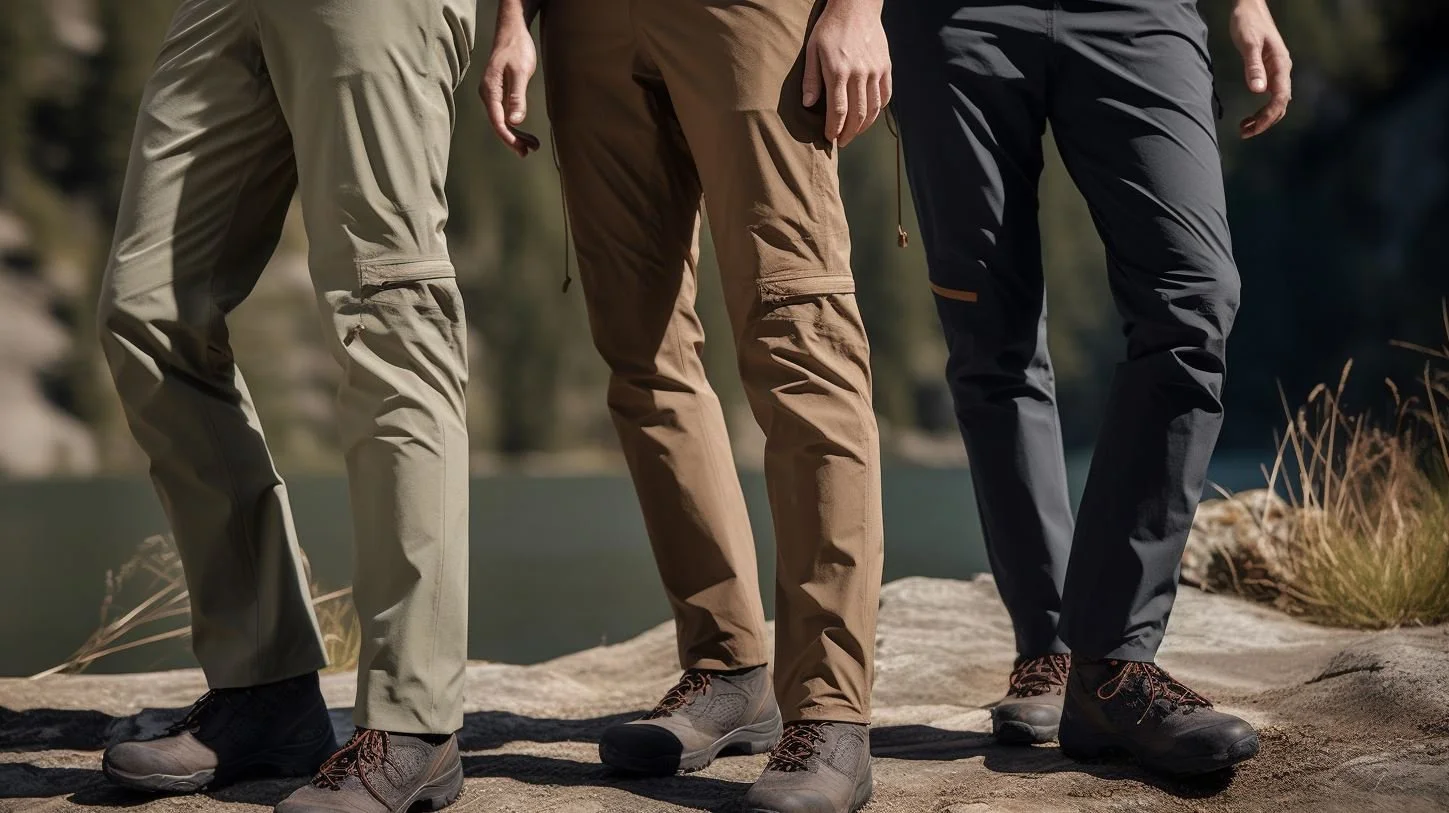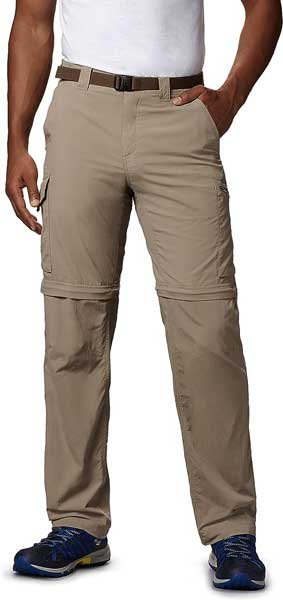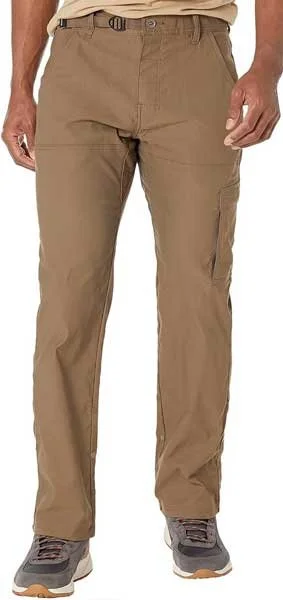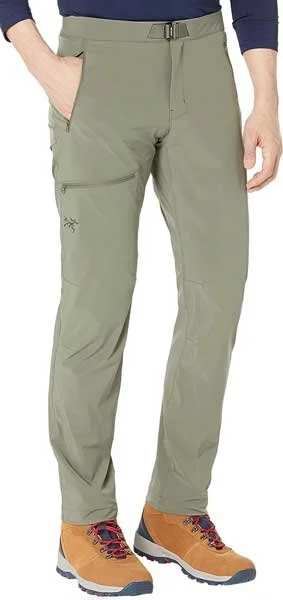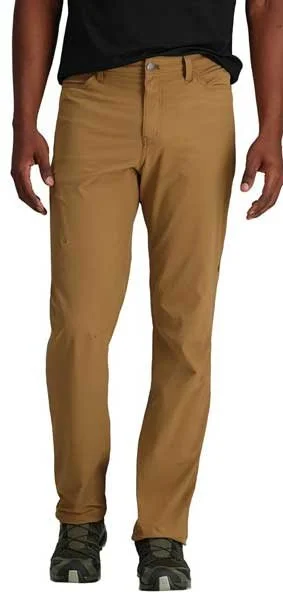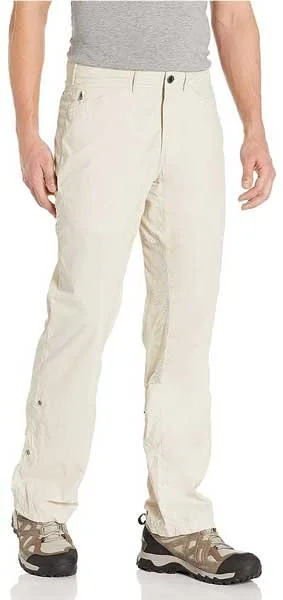Best Hot Weather Hiking Pants
Stay Cool, Move Freely: The Ultimate Guide to Hot Weather Hiking Pants
When the temperatures rise, nothing should hold back your adventurous spirit, especially not your gear. '
Whether you're traversing sun-baked desert trails or climbing tropical terrains, the right pair of hiking pants can make all the difference.
In this guide, we dive deep into the features you need in a pair of hot weather hiking pants and recommend the top choices on the market.
Say goodbye to sweaty discomfort and say hello to breathable, functional fashion on the trail!
Best Hot Weather Hiking Pants
Get ready to conquer sun-soaked trails with ease.
In this section, we'll present our top picks for the best hot weather hiking pants, ensuring you stay cool and comfortable throughout your outdoor adventures.
Most Affordable
Columbia Silver Ridge Pants
Known for their lightweight and breathable fabric, these pants also offer a convertible design to switch between pants and shorts.
Pros
- Convertible
- Moisture wicking
- UPF 50
- Durable ripstop nylon
Cons
- Pocket Closure: The hook and loop pocket closures might not be as durable or secure as zipped or buttoned pockets.
Best Mobility
Prana Stretch Zion II Pants
Made with a blend of nylon and spandex, these pants offer both durability and mobility. They also feature a water-repellent finish.
Pros
- Stretchy
- UPF 50
- Vented inseam
- Snap roll-up
- Integrated belt
- Water repellant
Cons
- Not truly convertible
Ultralight
Arc'teryx Gamma Lightweight Pant
This brand is known for its high-quality gear. The Gamma Pants are lightweight, quick-drying, and designed for serious hikers.
Pros
- Stretchy
- Durable & Lightweight
- Water repellant
- Integrated belt
- Legendary reputation
- Pant cuff drawcord
Cons
- Expensive
- Not truly convertible
Anti-Odor
The North Face Paramount Pants
Another convertible option that offers versatility. They come with UPF 50 protection and anti-odor technology.
Pros
- Stretchy
- Moisture wicking
- Abrasion resistant
- Water repellant
- Anti-odor
- Integrated belt
- Pant cuff drawcord
Cons
- Not truly convertible
- Slim fit
Lightweight Toughness
Outdoor Research Ferrosi Pants
Made with a blend of nylon and spandex, these pants are praised for their breathability and comfort in hot conditions.
Pros
- Stretchy
- Abrasion resistant
- UPF 50
- Quick drying
- Integrated belt
- Pant cuff drawcord
- 10.7oz
Cons
- Not truly convertible
Insect Repellant
ExOfficio BugsAway Sandfly Pants
Especially good for insect-prone areas, these pants come with an insect repellent treatment and are also lightweight for hot conditions.
Pros
- Insect protection (70 washes)
- Vented leg panels
- UPF 45
- 7.4oz
- Roll-up snaps
Cons
- No integrated belt
- Roll-up snaps only reach capri-length
- Not truly convertible
Buyer’s Guide
In hot weather, hiking can be both challenging and uncomfortable if you're not wearing the right gear. This guide will lead you through the key factors to consider when selecting the best hiking pants for hot conditions.
1. Material:
Breathability: Opt for materials like nylon or polyester blends. These fabrics allow sweat to evaporate quickly, which can be crucial in maintaining body temperature.
Moisture-Wicking: The fabric should effectively draw moisture away from your skin. This ensures that sweat doesn't accumulate, which can lead to chafing.
Quick-Drying: Should you get caught in a rain shower or need to cross a stream, you'll appreciate pants that dry quickly.
-
When you're hiking in hot weather, the material of your pants plays a pivotal role in ensuring you stay comfortable, cool, and safe from elements like UV radiation and insects. This guide delves into the specifics of materials to help you make the best choice for your hot weather hikes.
1. Nylon:
Pros: Lightweight, quick-drying, and durable. Resistant to abrasion, making it great for rough terrains.
Cons: Can sometimes feel less soft against the skin compared to other materials.
2. Polyester:
Pros: Also lightweight and quick-drying. It wicks moisture away efficiently, which can be essential in humid conditions.
Cons: Can retain odors more than other materials.
3. Nylon-Polyester Blend:
Pros: Combines the benefits of both materials, resulting in a durable, lightweight, and moisture-wicking fabric.
Cons: The blend ratio can affect its feel and performance, so it's crucial to consider the specific percentages.
4. Spandex (Elastane):
Pros: Often blended in small amounts with other fabrics to provide stretch. This allows for greater mobility and a more snug fit.
Cons: Too much spandex can trap heat, making the pants less breathable.
5. Merino Wool:
Pros: Naturally breathable and moisture-wicking. Offers excellent temperature regulation and natural odor resistance.
Cons: Less durable than synthetic materials and can be more expensive. Not typically the primary material in hot weather hiking pants but sometimes used in blends.
6. Cotton:
Pros: Soft and comfortable.
Cons: Absorbs moisture and dries slowly, which can be problematic in hot and humid conditions. It's generally not recommended as a primary material for hiking pants but can be found in certain blends.
7. Treated Materials:
UPF Protection: Many fabrics are treated to enhance their Ultraviolet Protection Factor. This treatment helps protect your skin from harmful UV rays. Look for a UPF rating of 30 or more.
Insect Repellent: Some materials come pre-treated with permethrin or other repellents to ward off ticks, mosquitoes, and other pests.
DWR (Durable Water Repellent): A treatment applied to the fabric to make it water-resistant, ensuring that light rain or splashes bead off.
8. Weave and Density:
Tighter weaves and denser materials generally offer better protection against UV rays and bugs but can be less breathable. Conversely, a looser weave can be cooler but may offer less protection.
2. Weight:
Lightweight pants are ideal. They won't weigh you down, and they tend to be more breathable than heavier fabrics.
-
In the world of hiking, every ounce matters. The weight of your gear can significantly influence your overall experience, especially during prolonged adventures in hot conditions. When it comes to hot weather hiking pants, understanding weight nuances can make a difference in your comfort and mobility. Let's delve deep into this vital aspect.
1. Understanding Weight Categories:
Ultralight: These are the lightest pants available, typically weighing under 10 ounces (283 grams) depending on the size. They prioritize weight savings over other features.
Lightweight: Weighing between 10 to 16 ounces (283 to 454 grams), they strike a balance between weight, durability, and features.
Midweight: These are more durable and might weigh between 16 to 24 ounces (454 to 680 grams). They can be suitable for variable conditions but might feel hotter in intense heat.
2. Benefits of Going Light:
Increased Comfort: Lighter pants often translate to more comfort in hot conditions, as there's less material weighing you down.
Enhanced Mobility: With less weight clinging to your legs, you can move more freely and nimbly across terrains.
Reduced Fatigue: On longer hikes, the cumulative effect of weight can lead to quicker fatigue. Lighter pants can mitigate this to some extent.
3. Potential Trade-offs:
Durability: Ultra-lightweight pants might sacrifice some durability. Lighter materials can be more susceptible to wear and tear, especially in rugged conditions.
Fewer Features: To save weight, some pants might have fewer pockets, less reinforced areas, or lack certain functionalities like convertibility.
Protection: Thinner materials might offer less protection against UV rays, insects, or thorny plants.
4. Material Influence on Weight:
Fabrics like nylon and polyester are popular for lightweight pants due to their strength-to-weight ratio. The type of weave and thickness of the material will also influence the weight.
5. Features and Add-ons:
Pockets: The number, type (e.g., zippered, mesh-lined), and size of pockets can add weight.
Reinforcements: Additional layers or more robust materials in high-wear areas like knees can increase weight but also durability.
Zippers and Hardware: Convertible pants with zippers, as well as other hardware like snaps or belt loops, can contribute to the overall weight.
6. Personal Considerations:
Duration of Hike: For short day hikes, weight might not be as crucial. However, for extended treks or multi-day adventures, it's a vital consideration.
Packing Strategy: If you're a minimalist hiker, you might lean more towards ultralight options. Those who prefer being prepared for every scenario might opt for slightly heavier pants with more features.
Terrain: Lightweight pants might not hold up as well in abrasive or rough terrains. Depending on where you're hiking, you might need to strike a balance between weight and durability.
3. UPF Protection:
Exposure to the sun is a major concern during hot weather hikes. Pants with UPF (Ultraviolet Protection Factor) ratings can offer protection against harmful UV rays. A UPF rating of 50 or more is ideal.
-
When you're hiking under the blazing sun, it's not just sunburns you need to worry about but the more insidious threat of prolonged UV radiation exposure. Ultraviolet Protection Factor (UPF) indicates how effectively clothing items shield your skin from these harmful rays. Let's embark on a journey to fully understand UPF protection in hiking pants.
1. UPF Explained:
What is UPF? UPF measures the fraction of UV rays a fabric allows to reach your skin. For instance, a UPF 50 fabric allows just 1/50th of the sun's UV radiation to pass through.
2. Understanding UPF Ratings:
Good Protection: UPF 15 to UPF 24.
Very Good Protection: UPF 25 to UPF 39.
Excellent Protection: UPF 40 to UPF 50+.
For hot weather hiking, you should aim for pants with UPF 30 or higher, ensuring you're getting a high degree of protection from UV rays.
3. Factors Influencing UPF in Fabrics:
Material: Synthetic fabrics like polyester and nylon are better at deflecting UV radiation than natural fibers like cotton.
Weave: Tighter weaves or knits usually offer higher UPF ratings because they have smaller spaces through which UV rays can penetrate.
Color: Darker colors tend to absorb more UV than lighter colors. This absorption reduces the risk of UV rays reaching your skin.
Moisture: Some fabrics can lose their UPF value when wet. It's crucial to ensure that your chosen pants maintain protection even if you sweat or encounter water.
Stretch: Overly stretched fabric can reduce UPF protection by widening the gaps in the weave or knit.
4. Benefits of UPF-Enhanced Pants:
Reduced Sunburn Risk: Direct protection against the skin reddening effects of UV rays.
Lowered Skin Cancer Risk: Continuous protection against UV rays can decrease the long-term risk of various skin cancers.
Avoidance of Sunscreen: With UPF pants, you don't need to apply sunscreen on covered areas, saving time and avoiding potential allergens.
5. Maintaining UPF Value:
Wash Care: Some fabrics can improve their UPF rating after a few washes as the fibers tighten. However, harsh detergents or bleaching agents might degrade the fabric and decrease its protective capability.
Avoid Fabric Softeners: These can break down the fabric and diminish UPF value.
Limit Wear and Tear: Over time, as fabrics become worn or faded, their UPF value can diminish.
6. Certification and Testing:
Look for pants that have been certified by reputable organizations or standards, like the ASTM (American Society for Testing and Materials). This ensures the UPF value claimed is accurate.
7. Additional Considerations:
UPF protection in pants is just one part of the sun protection equation. Remember to pair this with other protective measures, like wearing a wide-brimmed hat, UV protective sunglasses, and applying sunscreen on exposed skin.
4. Ventilation:
Some hiking pants come with zippered ventilation areas, often on the thighs or calves. This allows you to increase airflow as needed.
-
While hiking in hot conditions, keeping your body temperature regulated is of paramount importance. Ventilation in hiking pants is a key factor that can make a world of difference. This guide will walk you through the nitty-gritty of ventilation and why it's essential for your next sun-drenched trail adventure.
1. Importance of Ventilation:
Body Temperature Regulation: Proper ventilation allows your body to release heat more effectively, preventing overheating.
Moisture Management: By promoting air circulation, ventilated pants help in evaporating sweat, reducing the likelihood of chafing and discomfort.
2. Types of Ventilation Mechanisms:
Mesh Panels: These are strategically placed in areas prone to excessive sweating, like behind the knees or at the inner thighs. Mesh allows air to flow freely while keeping debris out.
Zippered Vents: Commonly found on the outer thigh or calf region, these can be zipped open to increase airflow and zipped close if conditions change.
Gusseted Crotch: This design improves mobility and enhances air circulation in the groin area.
Loose Fits and Roll-Up Designs: While not direct ventilation mechanisms, looser fits and the ability to roll up pants can enhance airflow around the legs.
3. Material & Ventilation:
Breathable Fabrics: Look for materials like lightweight nylon or polyester, which inherently allow for good air circulation.
Moisture-Wicking Properties: Fabrics that wick away sweat can complement the ventilation features by ensuring that moisture is drawn away from the skin.
4. Factors to Consider:
Hiking Environment: If you're hiking in an area prone to insects, having open vents might expose you to bug bites. Ensure the vents have a mesh covering or can be zipped closed.
Weather Conditions: While ventilation is crucial in hot weather, if you're hiking in variable conditions, the ability to control the ventilation (like with zippered vents) is beneficial.
Dirt and Debris: In certain terrains, open vents might allow more dirt or fine sand to enter. Again, vents with mesh linings can be advantageous here.
5. Balancing Ventilation with Protection:
UV Protection: Ensure that ventilated areas still offer UV protection, especially if the vents are large or are positioned in sun-exposed areas.
Abrasion Resistance: Mesh panels or vents should not compromise the pant's durability, especially if you're hiking in rugged terrains.
6. Maintenance and Durability:
Zippers: If opting for zippered vents, ensure the zippers are of good quality. Dirt and frequent use can wear them out, so periodic checks and gentle cleaning can extend their lifespan.
Mesh Durability: The mesh should be robust enough to withstand potential snags from thorns or rough surfaces.
5. Convertibility:
Convertible hiking pants can be transformed into shorts, making them versatile for fluctuating temperatures or conditions.
-
Hiking in fluctuating weather or varying terrains often requires a gear that adapts to the situation. Convertible hiking pants, which can easily transform from full-length pants to shorts and vice versa, are a popular solution for hikers wanting versatility. This guide will take you through everything you need to know about the convertibility feature.
1. Convertible Pants Explained:
Design: Convertible pants come with zippers, typically above the knee, allowing the wearer to detach the lower part of the pants and transform them into shorts.
2. Advantages of Convertibility:
Adaptability: Switch between pants and shorts based on weather, terrain, or personal comfort.
Packing Efficiency: Instead of carrying separate shorts and pants, one convertible pair can do the job of both, saving weight and space in your backpack.
Economic: Buying a single pair of convertible pants can be more cost-effective than purchasing both pants and shorts.
3. What to Look For:
Zipper Quality: The zippers should be durable, easy to use, and resistant to jamming or breaking. Additionally, consider pants with covered zippers to prevent dirt and debris from getting in.
Fit in Both Forms: The pants should be comfortable both as full-length pants and shorts. Ensure they don't become too tight or loose after conversion.
Seam Comfort: The area where the pants detach can sometimes cause irritation. Check for soft seams to avoid discomfort.
4. Length & Positioning:
Shorts Length: Consider how long the shorts will be once converted. Some might end up being too short or too long for your preference.
Zipping Position: While most designs convert above the knee, some might be below. Choose according to what feels comfortable and provides the right amount of coverage.
5. Other Functional Aspects:
Pocket Accessibility: Ensure that converting your pants doesn't make pockets inaccessible or uncomfortable.
UV Protection: Both the pants and shorts should offer adequate UPF protection, especially if you're hiking in sunny conditions.
Ventilation: If you're considering convertible pants for hot weather, the shorts version should offer good ventilation.
6. Aesthetic Considerations:
Style: Convertible pants, by nature, have visible seams. Some people don't mind this, while others might feel it looks too functional. Look for brands that make the seams as discreet as possible if this is a concern.
Color Options: Most convertible pants come in neutral or earthy tones. However, there are brands that offer a wider range of colors if you want to mix style with functionality.
7. Care and Maintenance:
Washing: Regularly check and clean the zippers to ensure they function smoothly. Avoid aggressive wringing, which might damage the zippers or seams.
Storage: When not using the detached parts, store them in a clean, dry place to prevent misplacement.
6. Fit and Mobility:
Look for pants with articulated knees or gusseted crotches, as these features can increase mobility. A slightly elastic or adjustable waistband can also provide a more comfortable fit.
-
Hiking is an active endeavor, and whether you're scaling a rugged peak or navigating a serene trail, the fit and mobility of your hiking pants play a crucial role in your overall experience. Let's dive into the world of fit and mobility to ensure your next hot weather hiking adventure is as comfortable as possible.
1. The Importance of Fit and Mobility:
Comfort: A well-fitting pair of pants will ensure you're comfortable throughout your hike, reducing potential distractions.
Performance: Good mobility allows for unrestricted movement, ensuring you can tackle any challenges the trail throws your way.
Safety: An ill-fitting pair can lead to chafing, restricted movement, or even tripping hazards.
2. Types of Fits:
Regular/Standard Fit: Offers a balanced profile that's neither too tight nor too loose. It's ideal for those who want a traditional feel.
Relaxed Fit: Provides more room in the thigh and buttock area. Suitable for those looking for a more generous cut.
Slim/Athletic Fit: Closer to the body, but designed with stretchy fabrics to maintain mobility. Ideal for those who want a modern, streamlined look without sacrificing movement.
3. Key Features for Mobility:
Gusseted Crotch: A diamond-shaped piece of fabric inserted into the crotch area reduces seam tension, allowing for greater freedom of movement.
Articulated Knees: Pre-shaped knee areas, mimicking the natural bend of the leg, offer enhanced comfort and flexibility.
Stretch Fabric: Materials like elastane or spandex offer elasticity, ensuring the pants move with you.
4. Waistband Considerations:
Adjustable Waistbands: Features like drawstrings or elastic sections ensure a snug fit regardless of body shape.
Integrated Belts: Some pants come with belts or cinch systems for on-the-go adjustments.
5. Leg and Hem Adjustments:
Drawstring Hems: Allow you to adjust the pants' length, useful when navigating wet terrains or when you need increased ventilation.
Zippered Ankles: Provide extra room when wearing hiking boots or for added ventilation.
6. Trying Before Buying:
Range of Motion Test: When trying on pants, mimic hiking movements like squatting, high stepping, or lunging to test their mobility.
Layering: Consider what you'll wear underneath, especially if you have specific hiking underwear or base layers.
7. Material & Fit:
Breathability: For hot weather, ensure that the close-fitting sections of the pants are still breathable to prevent excessive sweating.
Weight: Lightweight materials can enhance mobility and are generally more comfortable for hot weather hikes.
8. Tailoring:
If you find a pair of hiking pants you love but they don't fit perfectly, consider getting them tailored. Adjusting the length or taking in the waist can make a significant difference in fit.
9. Brand Sizing Differences:
Different brands may have slight variations in sizing. Always consult the brand's specific sizing chart, and if possible, read user reviews to gauge fit accuracy.
10. Fit vs. Functionality:
While fit and mobility are paramount, don't compromise on other essential features like UV protection, durability, and pocket configurations. A well-fitting pair that lacks other functionalities might not be ideal for hiking.
7. Pockets and Storage:
A few strategically placed pockets can be beneficial for storing small items like maps, a compass, or snacks. Just ensure they're not overly bulky or restrictive.
-
When embarking on a hiking adventure, especially in sweltering conditions, carrying essential items like a map, compass, or snack within easy reach can make a big difference. This guide aims to shed light on the importance of pockets and storage in hot weather hiking pants, ensuring your gear serves both function and convenience.
1. The Role of Pockets:
Accessibility: Pockets allow for quick access to crucial items without having to rummage through your backpack.
Efficiency: Reducing the need to stop and search for frequently used items can save time and energy.
Safety: Having essentials like a whistle or multi-tool close at hand can be vital in certain situations.
2. Types of Pockets:
Hand Pockets: These are the standard pockets on the sides. Look for ones deep enough to secure items without them falling out during rigorous activity.
Back Pockets: Found on the rear, these can be either patch-style or have a flap or zipper for added security.
Cargo Pockets: These larger pockets on the thigh offer additional storage. Ensure they sit flat when not in use to maintain a streamlined profile.
Hidden or Security Pockets: Often located inside other pockets, they’re designed for valuables, offering discreet storage.
Small Tool Pockets: Smaller pockets on the thigh, perfect for items like a knife or multi-tool.
3. Closure Systems:
Zippers: Provide the best security, ensuring items won't fall out.
Velcro: Offers quick access, but might wear out over time and catch on certain fabrics.
Buttons: Durable and secure but can be tricky to fasten with gloves or cold fingers.
Flaps: Often cover other closure types, providing added protection against debris and rain.
4. Positioning and Ergonomics:
Accessibility: Pockets should be easy to access, even with a backpack hip belt or climbing harness on.
Flat-lying Design: Bulky pockets can be uncomfortable and can snag on obstacles. Opt for designs that lie flat against the body.
Articulation: Pockets should be positioned so that they don't restrict movement, especially when filled.
5. Material and Durability:
Reinforced Stitching: Pockets should be reinforced to prevent tearing, especially when carrying heavier items.
Water Resistance: In regions prone to rain or crossing water bodies, pockets with water-resistant or quick-drying materials can be beneficial.
6. Size and Capacity:
Deep vs. Shallow: Depending on your needs, choose between deeper pockets for more storage or shallow ones for quick access.
Expansion Pleats: Some pockets come with pleats that expand for extra storage and contract when empty to maintain a slim profile.
7. Special Features:
Drainage Holes: If you're crossing rivers or get caught in the rain, pockets with tiny holes can help drain out water.
Internal Dividers: Useful for organizing items, preventing them from jumbling together.
Dedicated Loops or Clips: For securing keys or tools.
8. Aesthetic Considerations:
While functionality is paramount, the style and look of the pockets might matter to some hikers. Choose pants that strike a balance between aesthetics and function.
9. Balancing Storage with Weight:
Multiple, large pockets can add weight. For ultra-light hiking or if you're aiming to minimize weight, opt for pants with essential pockets only.
8. Durability:
Reinforced stitching, especially in high-stress areas like the knees and seat, can significantly increase the longevity of your pants.
-
Hiking, by nature, exposes you to a variety of terrains, from rocky paths to thickets filled with thorns. In such environments, the durability of your gear, especially your pants, becomes a paramount concern. This guide will provide insights into the world of durable hot weather hiking pants, ensuring you invest in a pair that lasts.
1. Why Durability Matters:
Cost-Effectiveness: A durable pair might be more expensive initially but will save you money in the long run by reducing the need for replacements.
Reliability: When traversing challenging terrains, the last thing you want is your pants giving out.
Protection: Durable pants shield you from harsh elements, providing protection against abrasions, cuts, or insect bites.
2. Fabric Types and Durability:
Nylon: Known for its resistance to wear and tear, it's a popular choice for hiking pants.
Polyester: While slightly less durable than nylon, it dries faster and can be more breathable, which is beneficial in hot weather.
Blended Fabrics: Combining materials like nylon and spandex can offer both durability and stretch.
3. Fabric Weight and Denier:
Weight: Lighter fabrics are cooler for hot weather but might sacrifice some durability. However, modern lightweight fabrics can still be robust.
Denier: A measure of fabric thickness. Higher denier usually indicates more durability, but it might also be heavier.
4. Reinforcements:
Critical Zones: Look for pants with reinforced knees, seat, and ankles – areas prone to more wear and tear.
Ripstop Fabric: Recognizable by its square grid pattern, it's designed to stop small tears from expanding, ensuring longevity.
5. Construction Quality:
Stitching: Double or triple stitching in critical areas can greatly enhance durability.
Seams: Flat, well-sealed seams prevent fraying and potential weak points.
Gusseted Crotch: This design reduces stress on the pants, especially during high movement activities, thereby increasing longevity.
6. Fasteners and Zippers:
Quality Zippers: Opt for pants with reputable zipper brands like YKK or Opti.
Metal vs. Plastic: Metal fasteners and buttons tend to be more durable than plastic, but they can heat up in the sun.
7. UV Resistance:
Prolonged sun exposure can weaken fabrics. For hot weather hiking, look for pants with UV-resistant materials, which not only protect your skin but also maintain the fabric's integrity.
8. Treatment and Care:
DWR (Durable Water Repellent): While mainly for water resistance, DWR can add a layer of protection against stains and spills, which can degrade fabric over time.
Care Instructions: Following washing and drying instructions can greatly extend the lifespan of your pants.
9. Fit and Durability:
Loose vs. Tight: A super tight fit can strain the fabric and stitching, reducing durability. A comfortable, slightly loose fit (without being baggy) often lasts longer.
10. Warranty and Brand Reputation:
Warranty: Brands confident in their product's durability often offer extended warranties.
Brand Reputation: Some brands are known for their durable products. Check reviews and forums for recommendations.
9. Insect Protection:
Some pants come treated with permethrin, a repellent that keeps ticks, mosquitoes, and other pests at bay. This can be a godsend in certain environments.
-
Whether you're navigating dense forests or traversing open fields, one of the nuisances hikers often face, especially in warm climates, is insects. From the itching annoyance of mosquitoes to the potential dangers of ticks, insect protection is an essential consideration for hot weather hiking pants. This guide will steer you through the intricacies of choosing pants that keep those pesky critters at bay.
1. The Importance of Insect Protection:
Disease Prevention: Certain insects, like ticks and mosquitoes, can transmit diseases such as Lyme disease or malaria.
Comfort: Insect bites can lead to discomfort, itching, and allergic reactions for some individuals.
2. Built-in Insect Repellent:
Permethrin-treated Fabric: Some hiking pants come pre-treated with Permethrin, an insect repellent. This treatment is effective for a certain number of washes (often around 70) and can be reapplied.
Insect Shield: This is a proprietary method of bonding Permethrin to fabric, ensuring long-lasting protection.
3. Fabric Density and Weave:
Tight Weave: A denser, tighter fabric weave can prevent insects, especially mosquitoes, from penetrating through to the skin.
Materials: Synthetic fabrics like nylon or polyester typically have a tighter weave compared to natural fabrics like cotton.
4. Pant Length and Design:
Full Length: Pants that fully cover your legs provide the best protection against insects.
Elastic or Drawstring Cuffs: These prevent insects from crawling up inside the pant legs.
5. Breathability vs. Protection:
While a tight weave is excellent for insect protection, it can compromise breathability. Opt for pants designed with vents or made from advanced fabrics that balance both aspects.
6. After-market Insect Repellents:
Permethrin Spray: If your pants aren't pre-treated, you can use a Permethrin spray. Remember always to apply it in a well-ventilated area and allow it to dry completely before wearing.
DEET and Picaridin: While these are more common for skin application, they can also be applied to clothing for added protection.
7. UV and Insect Protection:
Some pants combine both UPF (Ultraviolet Protection Factor) and insect protection, ensuring you're shielded from sun and bugs.
8. Color Considerations:
Light-colored pants can make it easier to spot ticks and other small insects before they become a problem.
9. Durability and Insect Protection:
Over time and with washing, the effectiveness of built-in repellents can diminish. Ensure you know the durability of the repellent treatment or be prepared to reapply as needed.
10. Environmental and Safety Considerations:
Eco-friendly Options: Some brands offer treatments that are biodegradable and have less environmental impact.
Safety: Always check for any potential skin reactions or allergies when choosing treated pants, especially if opting for aftermarket repellent applications.
10. Price vs. Quality:
While it's tempting to save money, cheaper pants may not last as long or offer the same level of protection and comfort as higher-quality options. Consider it an investment in your comfort and safety.
Top Recommendations:
Columbia Silver Ridge Convertible Pants: Ideal for the versatile adventurer who wants the flexibility of converting their pants to shorts.
Prana Stretch Zion II: Best suited for the eco-conscious explorer valuing stretch, breathability, and sustainability in their gear.
Arc'teryx Gamma Pants: For the serious outdoor enthusiast looking for a balance of mobility, wind resistance, and durable softshell protection.
The North Face Paramount Pants: Tailored for those who prioritize sustainable choices, with a mix of durability and comfort for extended hikes.
Outdoor Research Ferrosi Pants: A go-to for individuals seeking a lightweight yet durable pants with movement-mirroring stretch and multiple outdoor applications.
ExOfficio BugsAway Sandfly Pants: Perfect for trekkers wanting optimal bug protection without compromising on breathability and packability.
Conclusion
Navigating the maze of hiking gear can be daunting, but armed with the right information, you can make an informed choice tailored to your needs. '
Our goal has been to shed light on the features that matter and to present the best options for staying cool and protected during your hot weather hikes.
Remember, nature waits for no one, and with the right pants, you're ready for whatever the trail throws at you.
Here's to many more sun-soaked adventures with the perfect hiking companion - your ideal pair of pants!

